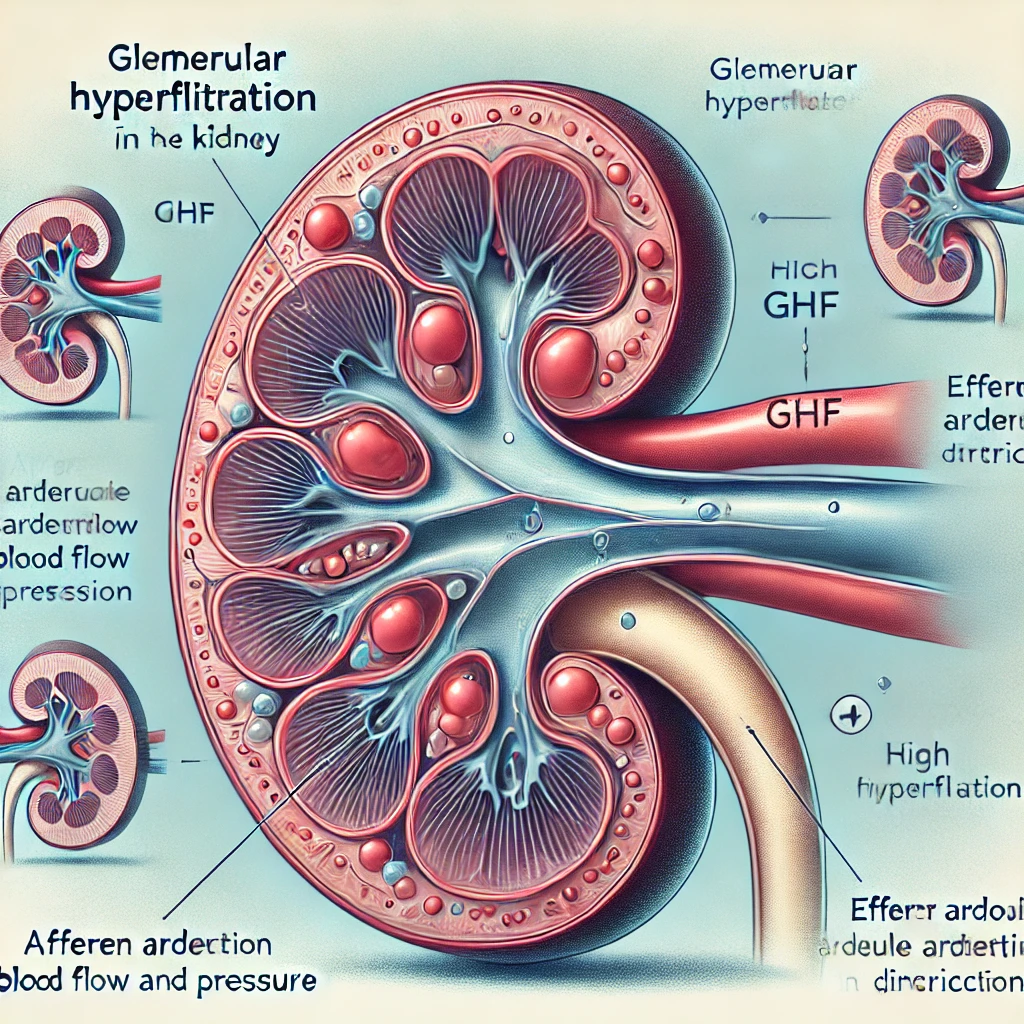Glomerular Hyperfiltration May Not Indicate Normal Kidney Function


When people first hear the term glomerular hyperfiltration (GHF), many assume, “Isn’t a high filtration rate a sign that the kidneys are working well?” While it might sound like a good thing, GHF actually reflects a state of abnormally increased kidney workload. It can be an early sign of kidney damage and is closely associated with a higher risk of cardiovascular disease (CVD).
Recent large-scale studies have shown that GHF is not just an early feature of diabetes but an independent cardiovascular risk factor, especially in younger patients. In this post, we’ll explore what GHF is, its underlying mechanisms, its connection to diabetes and other conditions, and why it’s important to detect it early—even in people without diabetes.
🔬 What is Glomerular Hyperfiltration (GHF)?
The glomerulus is the part of the kidney that filters blood—much like a fine biological filter. The glomerular filtration rate (eGFR) measures how efficiently your kidneys perform this task. A normal eGFR usually ranges from 90 to 120 ml/min/1.73m².
But when eGFR is abnormally high—often above the 95th percentile for someone’s age and sex—it may indicate glomerular hyperfiltration.
Rather than signaling healthy kidney function, GHF suggests the kidneys are overworking, often silently, and can lead to:
-
Glomerular hypertension
-
Proteinuria
-
Progressive kidney damage (CKD)
-
Increased cardiovascular risk
⚙️ Why Is GHF Harmful? – Pathophysiology
GHF affects both the kidneys and cardiovascular system through multiple complex mechanisms:
1. Intraglomerular Hypertension
Increased blood flow into the glomerulus raises the pressure inside, damaging the delicate capillaries. Over time, this can lead to glomerulosclerosis and systemic vascular strain.
2. Suppression of Tubuloglomerular Feedback (TGF)
In diabetes, increased sodium-glucose reabsorption suppresses TGF, leading to afferent arteriole dilation → more blood flow → GHF.
3. Activation of the RAAS (Renin-Angiotensin-Aldosterone System)
This raises blood pressure and contributes to cardiac remodeling, hypertrophy, and eventual heart failure.
4. Oxidative Stress and Inflammation
GHF triggers reactive oxygen species and cytokines that damage endothelial cells, promoting atherosclerosis and CVD.
5. Increased Arterial Stiffness
GHF may affect large vessels, impairing diastolic function and leading to ventricular dysfunction.
📊 GHF and CVD – What the Research Says
A 2025 study from the Clinical Journal of the American Society of Nephrology (CJASN) followed 1.95 million patients with type 2 diabetes for up to 7 years.
Key findings:
-
CVD risk was 13% higher in those with GHF (HR 1.13)
-
Myocardial infarction risk rose by 6%, heart failure by 17%
-
Patients under 40 had the highest CVD risk increase (HR 1.30)
🔎 This reinforces GHF as a systemic risk marker, not just a kidney-specific phenomenon.
❓ Can GHF Occur Without Diabetes?
Absolutely. GHF can occur in people without diabetes, often due to:
• Obesity and Metabolic Syndrome
Insulin resistance suppresses TGF and increases renal blood flow.
• Early Hypertension
Increased sympathetic tone and RAAS activation lead to hyperfiltration.
• High-Protein Diets
Excessive protein intake may temporarily increase GFR—chronic overconsumption may lead to persistent GHF.
• Pregnancy
eGFR physiologically increases during the 2nd–3rd trimester. If underlying renal issues exist, GHF may become pathologic.
• Other Causes
-
Post-exercise (transient)
-
Solitary kidney (e.g., kidney donors)
-
Early polycystic kidney disease
-
Growth spurts in adolescence
🧠 The Role of eGFR Percentiles – Not Just the Number
A single eGFR value doesn’t provide the whole picture. That’s why this study used eGFR percentiles based on age and sex to define GHF.
For example:
| Age | eGFR (ml/min/1.73m²) | Interpretation |
|---|---|---|
| 25-year-old woman | 110 | Normal |
| 70-year-old woman | 110 | Likely GHF (above age-specific 95th percentile) |
This percentile approach enables more personalized, accurate risk stratification.
📋 Clinical Implications of GHF
GHF is often asymptomatic, but early identification can help prevent long-term damage.
🔹 How to Identify High-Risk Patients:
-
eGFR above age/sex 95th percentile
-
Even with “normal” values, reassess if the patient is young or non-obese
-
Check for trace proteinuria or signs of early cardiovascular dysfunction
🔹 What to Do if GHF is Suspected:
-
Lifestyle: reduce salt, avoid excess protein, manage weight
-
Medications: consider SGLT2 inhibitors or RAAS blockers (ACEi/ARB)
-
Monitor: reassess eGFR and urinary protein regularly
📌 Summary
| Feature | GHF Risk Increases In… |
|---|---|
| Age | Under 40 years |
| Sex | Males |
| Obesity | Non-obese individuals |
| Hypertension | Those without HTN |
| Dyslipidemia | Those without dyslipidemia |
Glomerular hyperfiltration is not a sign of kidney vitality.
It’s often an early warning signal—especially in young, lean individuals with no other obvious risk factors.
Early lifestyle changes and monitoring can significantly reduce long-term kidney and heart damage.
✅ Summary Tips
-
GHF reflects early kidney stress—not enhanced function
-
It occurs in both diabetics and non-diabetics
-
CVD risk is highest in young, non-obese individuals with GHF
-
Age/sex-adjusted eGFR percentiles offer better risk assessment
-
Early detection and lifestyle intervention are key
Recent Posts
A Gene-Edited Pig Kidney in a Human — A Medical Miracle Becomes Reality
🐷 A Pig’s Kidney in a Human Body? Sounds like science fiction — but in…
How to Protect Your Kidneys While Dining Out
Dining out can be tricky for people with chronic kidney disease (CKD) or those concerned…
How to Start the Habit of Eating Less Salt
Introduction: Why Change the Habit of Eating Salty Food? Korean cuisine traditionally relies heavily on…
Q. It’s summer and I’m sweating a lot—can I drink more water even though I’m on a fluid restriction?
During hot summer months, we sweat more and naturally feel thirstier. But if you’ve been…
Summer Hydration for Kidney Patients: Your Comprehensive Guide to Staying Healthy
The scorching summer heat often sends us reaching for a refreshing glass of water to…
Diabetic Kidney Disease (DKD): Is Prevention Really Possible? Your Complete Guide
Introduction: Diabetes and Its Hidden Threat, Diabetic Kidney Disease In today's society, diabetes is no…